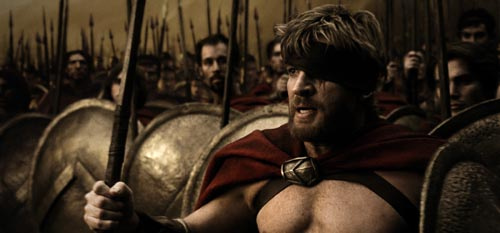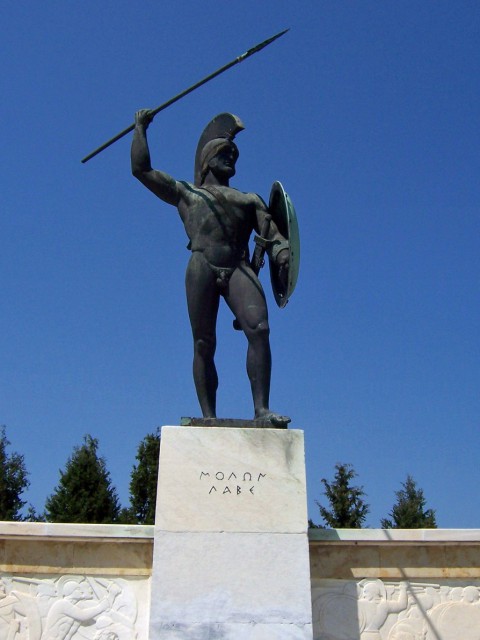When looking at the movie 300, most people with a knowledge of history look at it like any other Hollywood history movie such as Gladiator or Kingdom of Heaven and pick it apart with complaints that the Spartan’s never wore leather speedos and the Persians didn’t have war rhinos.
The problem is that 300 is not at all meant to transport a viewer to another time, it is meant to tell a story. Most importantly of all, the movie 300 is intended to be the story as the Spartans of that time would tell it.

This character is based off of the historical Spartan Aristodemus, who left Thermopylae with some eye infection and was actually the subject of ridicule until he redeemed himself at Plataea.
When looking at the film through the narrator’s storytelling, everything changes. Firstly, Leonidas was 60 years old by the time of the battle but for the sake of a glorious story he is presented as an older, but still physically fit soldier. Not all Spartan kings historically went through the agoge training but Leonidas actually did, hence making it worthy of mention in the film.
Another main aspect of the movie that makes perfect sense is the look of the Spartans. Their appearance makes them look more like models than soldiers as they lack body armor. In ancient warfare many warriors fought without armor to show their daring and bravery, and while the Spartans were smart enough to wear full armor, they would not have thought twice about presenting a story where they bravely fought with no armor.
To go along with this, the Spartans would certainly have been incredibly fit with large muscles. Their training built up their strength and speed far more than any other fighters of the time.

While it is true that the Spartans held Thermopylae with the help of around 7,000 Greek allies and many hundreds of slaves, the glory certainly went to the Spartans. The thousands of Greeks fought the Persians along the narrow pass just as was shown in the first actual charge in the movie.
It is impossible to know if this tight phalanx was utilized throughout the battles and there are theories that suggested that hoplites did occasionally engage in looser “Homeric” styles of warfare so the widening of the formation to push through the Persians is unlikely but certainly not impossible when looking at all of the possibilities of hoplite warfare.
Throughout the battle the fresh units of Hoplites rotated into the battle and the Spartans consistently proved their quality on every outing.
The movie 300 has way more historical value than you might think
SHARES
| FacebookTwitter |
They may have had face covering, though made of cloth not metal, and certainly had a profound reputation. It is easy to understand their appearance in the movie as vilifying and building up opponents only gave more glory to the Greeks who beat them. The Spartans were again the ones who stood out as the specific troops who routed the immortals.
As in the movie, the Persians were shown a hidden goat path by Greek traitor Ephialtes, though he was a run of the mill Greek traitor. Greeks were rather notorious for betraying each other to the Persians or to other Greeks. As this betrayal doomed the Greeks, Ephialtes would have been given a grotesque appearance in a Spartan retelling.
Believe it or not “300” actually undersells the last stand of the 300. Rather than being hopelessly defeated by countless archers, the final stand was a brutal day of fighting that saw the Greeks ultimately fighting with their bare hands after their weapons were destroyed by the fighting. And two of Xerxes’ brothers were supposedly killed during this last bit of fighting as the remaining Greeks retreated to a hilltop and perished after the immortals pushed into the fight again.

As the story was told over and over it is not a stretch to see how its legend grew with each retelling to finally reach the fantastical retelling seen in the final film. Though this is a modern movie with many directing choices affecting the story, it is surprisingly accurate in telling a tale as the Spartans would have told it. Director Zac Snyder has said that the movie is a “fantasy film…an opera, not a documentary” and that the films narrator is “a guy who knows how not to wreck a good story with truth.”
What needs to be understood is that this is certainly how many of the Greeks thought and without mass media, many opinions were formed by hearing an oft repeated story such as this. After the Persian War the Spartans enjoyed an even more dangerous reputation and the Athenians as well for playing major roles at Salamis and Plataea.
Though the Persians lost, they were still feared by the Greeks. The later Athenian Delian league was created because the fear of Persia was still very real and even the later Alexander-led Macedonians had their doubts about successfully invading Persia.
By William McLaughlin for War History Online

Δεν υπάρχουν σχόλια:
Δημοσίευση σχολίου